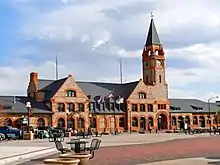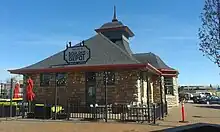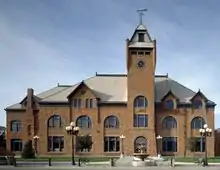Front Range Passenger Rail
Front Range Passenger Rail is a proposed inter-city passenger train service along the Front Range and broader I-25 corridors in Colorado and Wyoming. Most proposals envision a route from Pueblo north to Colorado Springs, Denver, Boulder, Fort Collins, and usually Cheyenne. Extensions south to Trinidad, Albuquerque, and even El Paso have been discussed.
.jpg.webp) A long-distance Amtrak train in Colorado | ||||||||||||||||||||||||||||||||||||||||||||||||||||||||||||||||||||||||||||||||||||||||||||||||||||||||||||||||||||||||||||||||||||||||||||||||||||||||||||||||||||||||||||||||||||||||||||||||||||||||||||||||||||||||||||||||||||||||||||||||||||||||||||||||||||
| Overview | ||||||||||||||||||||||||||||||||||||||||||||||||||||||||||||||||||||||||||||||||||||||||||||||||||||||||||||||||||||||||||||||||||||||||||||||||||||||||||||||||||||||||||||||||||||||||||||||||||||||||||||||||||||||||||||||||||||||||||||||||||||||||||||||||||||
|---|---|---|---|---|---|---|---|---|---|---|---|---|---|---|---|---|---|---|---|---|---|---|---|---|---|---|---|---|---|---|---|---|---|---|---|---|---|---|---|---|---|---|---|---|---|---|---|---|---|---|---|---|---|---|---|---|---|---|---|---|---|---|---|---|---|---|---|---|---|---|---|---|---|---|---|---|---|---|---|---|---|---|---|---|---|---|---|---|---|---|---|---|---|---|---|---|---|---|---|---|---|---|---|---|---|---|---|---|---|---|---|---|---|---|---|---|---|---|---|---|---|---|---|---|---|---|---|---|---|---|---|---|---|---|---|---|---|---|---|---|---|---|---|---|---|---|---|---|---|---|---|---|---|---|---|---|---|---|---|---|---|---|---|---|---|---|---|---|---|---|---|---|---|---|---|---|---|---|---|---|---|---|---|---|---|---|---|---|---|---|---|---|---|---|---|---|---|---|---|---|---|---|---|---|---|---|---|---|---|---|---|---|---|---|---|---|---|---|---|---|---|---|---|---|---|---|---|---|---|---|---|---|---|---|---|---|---|---|---|---|---|---|---|---|---|---|---|---|---|---|---|---|---|---|---|---|---|---|---|---|
| Service type | Inter-city rail | |||||||||||||||||||||||||||||||||||||||||||||||||||||||||||||||||||||||||||||||||||||||||||||||||||||||||||||||||||||||||||||||||||||||||||||||||||||||||||||||||||||||||||||||||||||||||||||||||||||||||||||||||||||||||||||||||||||||||||||||||||||||||||||||||||
| Status | Proposed | |||||||||||||||||||||||||||||||||||||||||||||||||||||||||||||||||||||||||||||||||||||||||||||||||||||||||||||||||||||||||||||||||||||||||||||||||||||||||||||||||||||||||||||||||||||||||||||||||||||||||||||||||||||||||||||||||||||||||||||||||||||||||||||||||||
| Locale | Colorado and Wyoming | |||||||||||||||||||||||||||||||||||||||||||||||||||||||||||||||||||||||||||||||||||||||||||||||||||||||||||||||||||||||||||||||||||||||||||||||||||||||||||||||||||||||||||||||||||||||||||||||||||||||||||||||||||||||||||||||||||||||||||||||||||||||||||||||||||
| Website | www | |||||||||||||||||||||||||||||||||||||||||||||||||||||||||||||||||||||||||||||||||||||||||||||||||||||||||||||||||||||||||||||||||||||||||||||||||||||||||||||||||||||||||||||||||||||||||||||||||||||||||||||||||||||||||||||||||||||||||||||||||||||||||||||||||||
| Technical | ||||||||||||||||||||||||||||||||||||||||||||||||||||||||||||||||||||||||||||||||||||||||||||||||||||||||||||||||||||||||||||||||||||||||||||||||||||||||||||||||||||||||||||||||||||||||||||||||||||||||||||||||||||||||||||||||||||||||||||||||||||||||||||||||||||
| Track gauge | 4 ft 8+1⁄2 in (1,435 mm) standard gauge | |||||||||||||||||||||||||||||||||||||||||||||||||||||||||||||||||||||||||||||||||||||||||||||||||||||||||||||||||||||||||||||||||||||||||||||||||||||||||||||||||||||||||||||||||||||||||||||||||||||||||||||||||||||||||||||||||||||||||||||||||||||||||||||||||||
| ||||||||||||||||||||||||||||||||||||||||||||||||||||||||||||||||||||||||||||||||||||||||||||||||||||||||||||||||||||||||||||||||||||||||||||||||||||||||||||||||||||||||||||||||||||||||||||||||||||||||||||||||||||||||||||||||||||||||||||||||||||||||||||||||||||
Front Range communities were historically connected by rail transit until the mid-20th century. A series of studies performed since the early 2000s have shown mounting interest in renewed service. Momentum has grown significantly in the 2020s with Colorado creating the Front Range Passenger Rail District and Amtrak including the route in its 15-year expansion vision.
As of 2023, the Colorado Department of Transportation is working on a service development plan for the core route between Pueblo and Fort Collins. The plan will enable the state to solicit funding from voters and from the federal government.
History





In the 19th century, the Atchison, Topeka and Santa Fe Railway and Denver and Rio Grande Western Railroad each built lines along the Front Range (now owned by BNSF and Union Pacific, respectively). Pueblo–Denver passenger service existed until the formation of Amtrak in 1971.[1] The Denver–Cheyenne segment was last served in 1997 by the Pioneer.
In 1989, rail supporters involved in preserving Denver Union Station formed the nonprofit Colorado Rail Passenger Association (ColoRail). The group has regularly advocated for the Front Range route,[2] and in 1997 played a role in starting Amtrak Thruway bus service along the corridor from Denver to Raton.[3]
With the 1998 Transportation Equity Act for the 21st Century, Congress authorized the US Department of Transportation to designate eleven federal high-speed rail corridors for targeted development. Ten were listed by the December 2001 funding deadline, though none in the mountain west.[4] In March 2002, the Colorado Department of Transportation (CDOT) nevertheless applied for designation of the "Rocky Mountain High Speed Rail Corridor" along I-25 and I-70.[5] The corridor has yet to be designated.
Rocky Mountain Rail Authority
In December 2004, Colorado State Representative Bob Briggs of Westminster founded the Front Range Commuter Rail organization. The stated goal of the organization was to start commuter rail along the Front Range by the time the Regional Transportation District's FasTracks mass transit started service in 2014. The proposed line was dubbed the "RangerXpress"[6] and received high-profile support from Colorado Senator Ken Salazar.[7]
In September 2006, the Colorado Transportation Commission approved a $1,246,000 grant for a high-speed rail feasibility study on corridors in Colorado, including the Front Range.[8] Although Front Range Commuter Rail had applied for the grant, CDOT required that the money go to a local government body. To this end, several counties and municipalities in Colorado formed the Rocky Mountain Rail Authority (RMRA) that November. The authority eventually grew to 45 members.[9][10] By May 2007, the RMRA had raised over $415,000 in matching funds, exceeding the required 20% match on the CDOT grant. RMRA committed the final $325,000 the following month.
Work on the RMRA study began in June 2008 and it was released in March 2010.[11] It found that the I-25 corridor would meet the Federal Railroad Administration (FRA) criteria for technical and economic feasibility, including positive cost-benefit and farebox recovery ratios.[12]
In July 2011, the Colorado Secretary of State marked Front Range Commuter Rail as a delinquent organization effective June 1, 2010.[13]
Division of Transit and Rail
In May 2009, Colorado Governor Bill Ritter signed a bill creating the Division of Transit and Rail (DTR) within CDOT.[14] The division is responsible for developing rail services and administering state and federal rail funds in Colorado.[15] In March 2012, DTR released its first Colorado Freight and Passenger Rail Plan, which was required by the Passenger Rail Investment and Improvement Act of 2008 in order for Colorado to receive future FRA grants. The plan lists various versions of Front Range service as long-range projects.[16]
In April 2012, CDOT began an Interregional Connectivity Study (ICS) through an FRA grant, building on the 2010 RMRA study. Published in January 2014, the ICS recommended initial high-speed rail service between Fort Collins, Denver International Airport, and Briargate—a neighborhood of northern Colorado Springs—with future expansion to Pueblo. This alignment would bypass Boulder and downtown Denver via a new rail line built along the Colorado 470 beltway. The startup cost of the project was estimated at $9.81 billion with annual ridership of 13.6 million.[17]
In July 2015, CDOT began operating Bustang, an intercity bus service with several routes along the Front Range corridor.[18]
In July 2016, the Regional Transportation District (RTD) opened the initial 6.2-mile (10 km) section of the B Line from Denver to Westminster. An unfunded extension to Boulder and Longmont is planned for the 2040s.[19] This commuter rail line overlaps part of the route that later emerged as the favorite for Front Range Passenger Rail.[20]
Rail Commission
In spring 2017, Colorado enacted legislation creating the Southwest Chief & Front Range Passenger Rail Commission, effective July 1st of that year. The commission subsumed a body focused solely on supporting the long-distance Southwest Chief, taking on the additional task of developing passenger rail on the I-25 corridor. It is composed of representatives from CDOT, RTD, ColoRail, Amtrak, BNSF, Union Pacific, and various Colorado governments.[21][22] In 2018 the General Assembly allocated $2.5 million toward the commission's duties, including development of a Front Range Passenger Rail service plan.[23]
CDOT updated the Colorado Freight and Passenger Rail Plan in 2018, naming Front Range Passenger Rail a "priority objective" and "Colorado's most immediate opportunity to improve and expand rail mobility." The Division of Transit and Rail committed to advancing the project.[24]
In December 2020, the Rail Commission published an "Alternatives Analysis" that identified three feasible routes for the Pueblo–Fort Collins segment of Front Range service. The alternatives consisted of nine initial stations, 18 to 24 round trips per day, speeds up to 110 miles per hour (180 km/h), and end-to-end travel times of 2.5 to 3 hours. Annual ridership was estimated at 2.2 million and startup costs at $7.8 to $14.5 billion.[25][26]
In spring 2021, Amtrak included the Front Range route in its 2035 expansion vision.[27] As envisioned, the service would consist of three daily round trips between Pueblo and Fort Collins with one extending to Cheyenne. The end-to-end trip time would be 5 hours 34 minutes and the route would have an annual economic impact of $103 million.[28] This would be a state-supported Amtrak route similar to Illinois Service or NC By Train, meaning Colorado and Wyoming would shoulder much of the operating cost.[29]
Rail District
In June 2021, Colorado Governor Jared Polis signed a bill creating the Front Range Passenger Rail District in a ceremony at Pueblo Union Depot. The district spans all thirteen counties of the I-25 corridor in Colorado.[30] It will be overseen by a board of stakeholders similar to those of the Southwest Chief & Front Range Passenger Rail Commission, which the district officially replaced on July 1, 2022.[31] Notably, the board can ask voters to approve a new sales tax up to 0.8% within the district to pay for the train service, but only after making every effort to secure federal funding.[32]
In October 2021, the Colorado Transportation Commission approved the final $1.6 million of the $3.9 million needed for new Front Range service studies. The FRA had already awarded a $685,000 grant and the rest came from the Rail Commission. The studies will take about two years and result in a workable service plan that the Rail District can use to secure funding. The project would still need separate environmental review.[33]
In November 2021, Congress passed President Biden's Infrastructure Investment and Jobs Act (IIJA), which allocates $215 million to public transportation in Colorado, $66 billion to Amtrak, and tens of billions to competitive transportation grant programs.[34] Advocates think Front Range Passenger Rail is positioned to benefit from these funds.[35] In May 2022, the FRA launched the Corridor Development Program as the mechanism for new passenger rail projects to receive funds from the IIJA.[36] Colorado's four Democratic House members sent a letter to USDOT and the FRA requesting that Front Range service be funded by the program.[37][38][39]
In June 2022, Colorado allocated nearly $9 million in "early stage Front Range Passenger Rail funding."[40] $2.4 million went to the rail district, providing matching dollars for federal contributions. $6.5 million went toward the Burnham rail yard redevelopment project in Denver. The move was geared toward making Colorado competitive for federal IIJA funding.[41]
As of 2023, Governor Polis is pushing to put a funding measure for Front Range service on the ballot as soon as November 2024. Planner are working on a service development plan which will finalize the proposed route, station stops, and frequency, while estimating timeline and cost.[42]
New Mexico and Texas
In 2003, New Mexico Governor Bill Richardson announced plans for the Rail Runner Express, a commuter train between Belen, Albuquerque, and Santa Fe. To ensure passenger trains would have priority over freight, the state signed a $76 million agreement with BNSF in December 2005 to buy the line between Belen and Lamy. As part of the deal, BNSF insisted that the state also buy the line from Lamy to Trinidad, Colorado, that hosts the Southwest Chief and has been included in some plans for Front Range Passenger Rail expansion.[43] Governor Susana Martinez cancelled the purchase of this part of the line in March 2016.[44]
The American Recovery and Reinvestment Act of 2009 appropriated new funding for high-speed rail projects, renewing interest a possible "Rocky Mountain High Speed Rail Corridor". Colorado, New Mexico, and Texas sought designation for the Denver–Albuquerque–El Paso section of the I-25 corridor. In July 2009, in hopes of conducting a feasibility study, the states applied for $5 million in funds made available by the Passenger Rail Investment and Improvement Act of 2008.[45][46] No study materialized.
See also
- Colorado Joint Line – the rail corridor between Pueblo and Denver
References
- "Santa Fe Joining Amtrack [sic]". Brownsville Herald. April 21, 1971. p. 2. Retrieved August 12, 2014 – via Newspapers.com.

- "Colorado needs rail service from Ft. Collins to Pueblo". Colorado Rail Passenger Association. Retrieved November 23, 2021.
- Etsy, Jon; Souby, Jim. "A Brief History of ColoRail". Colorado Rail Passenger Association. Retrieved November 23, 2021.
- "Chronology of High-Speed Rail Corridors". Federal Railroad Administration, Department of Transportation. July 7, 2007. Archived from the original on November 30, 2009. Retrieved March 16, 2014.
- "Rocky Mountain Corridor" (PDF). Rocky Mountain Rail Authority. Archived from the original (PDF) on September 15, 2007.
- "Background". RangerXpress.com. Archived from the original on January 31, 2008. Retrieved November 22, 2021.
- Salazar, Ken (June 8, 2005). "SEN. SALAZAR ENDORSES FRONT RANGE HIGH SPEED RAIL" (Press release). Archived from the original on June 28, 2006.
- Leib, Jeffrey (September 17, 2006). "$22 million will fuel transit". Denver Post.
- "About". rockymountainrail.org. Rocky Mountain Rail Authority. Retrieved November 23, 2021.
- "Establishing Contract For The Rocky Mountain Rail Authority" (PDF). Rocky Mountain Rail Authority. Retrieved November 23, 2021.
- "Rail Feasibility Study". Rocky Mountain Rail Authority. Retrieved November 23, 2021.
- "High-Speed Rail Feasibility Study" (PDF). Rocky Mountain Rail Authority. March 2010. Retrieved November 30, 2021.
- "Front Range Commuter Rail - History and Documents". Colorado Secretary of State. Retrieved January 27, 2020.
- "GOV. RITTER CREATES TRANSIT AND RAIL DIVISION". Cherry Creek News. May 20, 2009. Retrieved December 9, 2021.
- "Transit & Rail". Colorado Department of Transportation. Retrieved December 9, 2021.
- "Colorado State Freight and Passenger Rail Plan" (PDF). Colorado Department of Transportation. March 2012. Retrieved December 9, 2021.
- "Interregional Connectivity Study Executive Summary" (PDF). Colorado Department of Transportation. January 2014. Retrieved November 30, 2021.
- "DOT Announces Service Start Date for Bustang™". Colorado Department of Transportation. April 15, 2015. Retrieved January 4, 2022.
- "Northwest Rail Line 2015 Fact Sheet" (PDF). Regional Transportation District. June 26, 2015. Retrieved November 23, 2021.
- Murray, Jon (April 23, 2021). "Front Range rail: Northwest route through Boulder emerges as favorite for line that could share track with RTD". The Denver Post. Retrieved November 24, 2021.
- "SB17-153 Southwest Chief And Front Range Passenger Rail Commission" (PDF). Colorado General Assembly. Retrieved November 23, 2021.
- "Southwest Chief & Front Range Passenger Rail Commission". Colorado Department of Transportation. Southwest Chief & Front Range Passenger Rail Commission. Retrieved November 23, 2021.
- "A Vision for Front Range Passenger Rail". Colorado Department of Transportation. Southwest Chief & Front Range Passenger Rail Commission. Retrieved November 23, 2021.
- "Colorado Freight and Passenger Rail Plan" (PDF). Colorado Department of Transportation. 2018. Retrieved December 12, 2021.
- "Alternatives Analysis Briefing" (PDF). Southwest Chief & Front Range Passenger Rail Commission. January 22, 2021. Retrieved January 4, 2022.
- "Alternatives Analysis". Front Range Passenger Rail. December 2020. Retrieved January 4, 2022.
- Heins, Nicole (April 13, 2021). "Amtrak hopes to reduce I-25 traffic by creating a passenger rail along the Front Range". KKTV 11 News. Retrieved November 24, 2021.
- "Front Range Corridor". Amtrak Connects US. Amtrak. Retrieved November 24, 2021.
- Murray, Jon (August 15, 2021). "Colorado's Front Range rail is still just an idea, but a Midwestern train shows what it could be". The Denver Post. Retrieved November 24, 2021.
- Luczak, Marybeth (July 1, 2021). "Report: Front Range Passenger Rail Moving Forward". Railway Age. Retrieved November 24, 2021.
- Gray, Matt; Esgar, Daneya; Zenzinger, Rachel; Garcia, Leroy. "SB21-238 Create Front Range Passenger Rail District". Colorado General Assembly. Retrieved November 24, 2021.
- Paul, Jesse (June 30, 2021). "Colorado takes its biggest step yet toward a Front Range passenger train system". The Colorado Sun. Retrieved November 24, 2021.
- Murray, Jon (October 22, 2021). "Front Range passenger rail proposal chugs forward with money to assess viability". The Denver Post. Retrieved November 26, 2021.
- Minor, Nathaniel (November 8, 2021). "Colorado is getting around $1 billion from the federal infrastructure bill for transportation projects". Colorado Public Radio. Retrieved November 24, 2021.
- Anderson, Mallory (December 4, 2021). "Front Range Passenger Rail closer to reality now that $1.2 trillion infrastructure package passed". KRDO. Retrieved December 5, 2021.
- Luczak, Marybeth (May 13, 2022). "FRA Launches Corridor ID Program". Railway Age. Retrieved May 23, 2022.
- "Neguse Leads Colorado Delegation Letter To DOT & FRA, Urges Funding For Colorado's Front Range Passenger Rail Project". neguse.house.gov. May 20, 2022. Retrieved May 23, 2022.
- "Neguse letter" (PDF). Joe Neguse. May 13, 2022. Retrieved May 23, 2022.
- Davis, Robert (May 20, 2022). "Colorado Democrats ask for federal funding for Front Range rail". KPVI. Retrieved May 23, 2022.
- Weiser, Scott (June 7, 2022). "Polis signs funding bill for Front Range Passenger Rail project". Denver Gazette. Retrieved June 9, 2022.
- McCluskie, Julie; Rankin, Bob; Hansen, Chris. "SB22-176: Early Stage Front Range Passenger Rail Funding". Colorado General Assembly. Retrieved June 9, 2022.
- Minor, Nathaniel (September 29, 2023). "Polis wants to land billions for Front Range rail. He's looking to local leaders for help". Colorado Public Radio. Retrieved September 29, 2023.
- Fonseca, Felicia (December 6, 2005). "New Mexico buys BNSF tracks for commuter rail". Casper Star-Tribune Online. Retrieved November 22, 2021.
- "Governor: NM scrapping deal to buy BNSF track". Albuquerque Journal. Associated Press. March 16, 2013. Retrieved November 22, 2021.
- Leib, Jeffrey (July 9, 2009). "Colo., Texas, N.M. seek high-speed passenger train". The Denver Post. Retrieved November 30, 2021.
- "NM seeks high-speed rail with Colorado, Texas". www.bizjournals.com. July 9, 2009. Retrieved November 30, 2021.